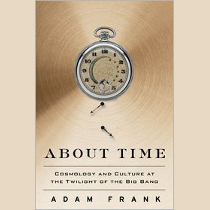 "About Time: Cosmology, Time and Culture at the Twilight of the Big Bang"
"About Time: Cosmology, Time and Culture at the Twilight of the Big Bang"
By Adam Frank, 2011
Time, as we perceive it, has always been closely intertwined with culture. And our understanding of time has grown steadily more exacting through the centuries, mirroring the more exact measurement of time brought by scientific advance. There was never an age when time and culture could be cleanly separated.
"When cultural time and cosmic time change, they change together," wrote astrophysicist Adam Frank in his 2011 book "About Time." Sometimes one leads, sometimes the other. This is not a surprise: Material engagement with the world has always served as a source of cultural and cognitive innovation.
Time was needed to coordinate an ever-more diverse range of human activities: food production, tools, domestic animals, villages, worship, procurement, burial. Most early cultures kept lunar (rather than solar) calendars. Moon cycles were short enough to count yet they could be used to capture longer durations. The lunar cycle has two distinct aspects: a variable position in the sky and changes in the moon's appearance. "Nature, embodied in celestial cycles, provides guideposts for ordering the work of the year," Frank wrote. But the farmer looked at the skies differently than the hunter-gatherer who came before him.
The advent of writing, about 12,000 years ago, came about as a necessary tool to keep track of man's increasing activities. In Babylon, priests became the first true astronomers, keeping long-term records of celestial events. The equally spaced 24-hour time measurement was invented by Babylonians but used only by astronomers at first.
Ptolemy was the first to create a truly accurate, geometric Geo-centric model of the celestial motion. In the year 1200, almost no one had use for exact time, by 1300 many European cities had mechanical clocks. By 1400, most of Europe was driven by clocks.
It was the Monasteries that introduced humans to the beat of the machine, Frank wrote, citing philosopher Lewis Mumford's essay " The Monastery and The Clock." In medieval times, the bells ruled activities of human enterprise--soon villagers had a hard time telling the bells for one appointment from the next. This helped spur the widespread adoption of clocks. "The mechanical regulation of time by machines freed cities of the cumbersome menagerie of bells," Frank noted.
New institutional facts demanded greater temporal accuracy. The minute hand came into use only in the mid-17th century, just prior to the industrial revolution.

In 1881, U.S railroads reshaped the meaning of time by settling on a single timetable regardless of location. Traveling between distant cities by train, travelers were forced to face the new and vexing issue of time standards. Local time was often set by high noon, which is different for each city.
The disparities did not matter before the train. This need for synchronization echoes the work of Newton two centuries earlier, in which he posited that absolute true mathematical time passes equally with relation to anything external.
The reordering of people's experience of time began with work and soon extended through all of their cultural and individual lives.
And progress marched forward. When the speed of light was discovered, it became obvious that looking out in space meant looking back in time. This was Einstein's space-time made manifest. Unlike Newton's comforting adherence to the universal, quantum physics demands that "No special frame of reference exists from which the motions of all others can be judged," Frank wrote.
The speed of light is the same for all observers, Einstein noted. Because this rule is hard-wired, we have something called "relativistic time dilation," in which time flows more slowly for objects moving closer to the speed of light. This is where we start to lose our innate understanding of time. "We have no hard-wired physics modules to provide instinctive understanding of relativity," Frank asserted.
At the same time, however, quantum physics also provided more accurate ways of measuring time. The rapid fire transitions of electrons within atoms -- a process called quantum jumps -- provide the basis for atomic clocks, by providing a steady atomic pulse with a variance of only 1 second every 30,000 years. The Russian launch of the Sputnik satellite led to the creation of the GPS system today. The work largely came from MIT reverse engineering frequency changes of the satellite's pulsing radio beacons.
Click here for more quotes and fun factoids from "About Time."